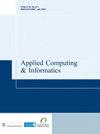An online emergency medical management information system using mobile computing
IF 4.9
Q1 COMPUTER SCIENCE, INFORMATION SYSTEMS
引用次数: 6
Abstract
PurposeThe purpose of this paper is to investigate the way technology affects the provision of prehospital emergency care, upgrading the quality of services offered and significantly reducing the risk of premature termination of the patients.Design/methodology/approachThe paper presents the development of the eEKAB, a pilot emergency medical information system that simulates the main services offered by the Greek National Instant Aid Centre (EKAB). The eEKAB was developed on an agile system methodology. From a technical perspective, the features and the technology were mainly chosen to provide reliable and user-friendly interfaces that will attract many users. eEKAB is based on three important pillars for offering health care to the patients: the “On-time Incident Reporting”, the “On-time Arrival at the Incident” and “Transfer to the Health Center”. According to the literature review, the emergency medical services (EMS) systems that combine all the features are very few.FindingsIt reduces the total time of the EMS procedures and it allows for an easier management of EMS, by providing a better allocation of human resources and a better geographical distribution of ambulances. The evaluation displayed that it is a very helpful application for the ambulance drivers as it reduces the ambulance response time to arrive in the patient's location and contributes significantly to the general performance of the prehospital medical care system. Also, the survey verified the importance of implementing eEKAB on a larger scale beyond the pilot usage. It is worth mentioning that the younger ambulance drivers had a more positive view for the purpose of the application.Research limitations/implicationsThe paper clearly identifies implications for further research. Regarding interoperability, the mobile app cooperates with the Operational Center of EKAB, while further collaboration could be achieved with other operational ambulance handling center, mainly, of the private sector. The system can evolve to include better communications among the EKAB departments. Particularly, the ambulance crew as well as the doctors should be informed with more incident features such as the emergency signal so that they know whether to open the siren, the patient's name, etc. The authors are currently working on implementing some features to provide effective medical health services to the patient in the ambulance.Practical implicationseEKAB will have very significant implications in case of its enforcement, such as the reduction of the total time of EMS procedures with a corresponding reduction of the operating costs of an accident management system and an ambulance fleet handling system while in parallel informing in time the doctors/clinics. It will provide better distribution of ambulances as well as of total human resources. It will greatly assist ambulance drivers, while reducing ambulance response time to reach the patient's location. In other words, the authors will have a better performance of the whole prehospital care system.Social implicationsProviding emergency care before the hospital is of great importance for upgrading the quality of health services provided at the accident site, thus significantly reducing the risk of premature death of patients. This in itself has a significant social implication.Originality/valueThe paper demonstrates a solid understanding in the field of the EMS systems and the corresponding medical services offered. It proposes the development of an effective, feasible and innovative EMS information system that will improve the existing emergency health care system in Greece (EKAB). An in depth literature review and presentation of the adopted new technologies and the respective architecture take place. An evaluation and statistical validation were conducted for proving the high applicability of eEKAB in case of real-life running.基于移动计算的在线紧急医疗管理信息系统
目的本文的目的是研究技术如何影响院前急救的提供,提高所提供的服务质量,并显著降低患者提前终止妊娠的风险。设计/方法/方法本文介绍了eEKAB的开发,这是一个试点的紧急医疗信息系统,模拟了希腊国家紧急援助中心(EKAB)提供的主要服务。eEKAB是在敏捷系统方法论的基础上开发的。从技术角度来看,选择这些功能和技术主要是为了提供可靠和用户友好的界面,吸引许多用户。eEKAB基于为患者提供医疗保健的三个重要支柱:“及时事件报告”、“及时到达事件现场”和“转移到健康中心”。根据文献综述,结合所有特征的紧急医疗服务(EMS)系统很少。Findings它通过提供更好的人力资源分配和救护车的更好地理分布,减少了EMS程序的总时间,并使EMS的管理更加容易。评估显示,它对救护车司机来说是一个非常有用的应用程序,因为它减少了救护车到达患者所在地的响应时间,并对院前医疗保健系统的总体性能做出了重大贡献。此外,调查还验证了在试点使用之外更大规模地实施eEKAB的重要性。值得一提的是,年轻的救护车司机对申请的目的持更积极的看法。研究局限性/含义该论文明确指出了进一步研究的含义。在互操作性方面,该移动应用程序与EKAB的运营中心合作,同时可以与其他运营救护车处理中心(主要是私营部门)实现进一步合作。该系统可以发展为包括EKAB部门之间更好的沟通。特别是,救护人员和医生应该了解更多的事件特征,如紧急信号,以便他们知道是否打开警笛、患者姓名等。作者目前正在实施一些特征,为救护车上的患者提供有效的医疗健康服务。实际影响EKAB在执行时将产生非常重大的影响,例如缩短EMS程序的总时间,同时相应降低事故管理系统和救护车车队处理系统的运营成本,同时及时通知医生/诊所。它将提供更好的救护车分配以及总的人力资源。它将极大地帮助救护车司机,同时减少救护车到达患者所在地的响应时间。换句话说,作者将在整个院前护理系统中有更好的表现。社会影响在医院前提供紧急护理对于提高事故现场提供的医疗服务质量至关重要,从而显著降低患者过早死亡的风险。这本身就具有重要的社会意义。原创性/价值本文展示了对EMS系统和所提供的相应医疗服务领域的扎实理解。它建议开发一个有效、可行和创新的EMS信息系统,以改善希腊现有的紧急医疗保健系统(EKAB)。对所采用的新技术和各自的体系结构进行了深入的文献回顾和介绍。为了证明eEKAB在实际跑步中的高度适用性,进行了评估和统计验证。
本文章由计算机程序翻译,如有差异,请以英文原文为准。
求助全文
约1分钟内获得全文
求助全文
来源期刊

Applied Computing and Informatics
Computer Science-Information Systems
CiteScore
12.20
自引率
0.00%
发文量
0
审稿时长
39 weeks
期刊介绍:
Applied Computing and Informatics aims to be timely in disseminating leading-edge knowledge to researchers, practitioners and academics whose interest is in the latest developments in applied computing and information systems concepts, strategies, practices, tools and technologies. In particular, the journal encourages research studies that have significant contributions to make to the continuous development and improvement of IT practices in the Kingdom of Saudi Arabia and other countries. By doing so, the journal attempts to bridge the gap between the academic and industrial community, and therefore, welcomes theoretically grounded, methodologically sound research studies that address various IT-related problems and innovations of an applied nature. The journal will serve as a forum for practitioners, researchers, managers and IT policy makers to share their knowledge and experience in the design, development, implementation, management and evaluation of various IT applications. Contributions may deal with, but are not limited to: • Internet and E-Commerce Architecture, Infrastructure, Models, Deployment Strategies and Methodologies. • E-Business and E-Government Adoption. • Mobile Commerce and their Applications. • Applied Telecommunication Networks. • Software Engineering Approaches, Methodologies, Techniques, and Tools. • Applied Data Mining and Warehousing. • Information Strategic Planning and Recourse Management. • Applied Wireless Computing. • Enterprise Resource Planning Systems. • IT Education. • Societal, Cultural, and Ethical Issues of IT. • Policy, Legal and Global Issues of IT. • Enterprise Database Technology.
 求助内容:
求助内容: 应助结果提醒方式:
应助结果提醒方式:


